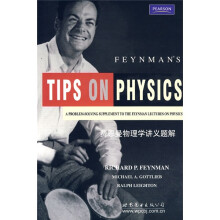Introduction
On the Origins of The Feynman
Lectures on Physics
A MEMOIR BY MATTHEW SANDS
1 Prerequisites
REVIEW LECTURE A
1-1 Introduction to the review lecture
1-2 Caltech from the bottom
1-3 Mathematics for physics
1-4 Differentiation
1-5 Integration
1-6 Vectors
1-7 Differentiating vectors
1-8 Line integrals
1-9 A simple example
1-10 Triangulation
2 Laws and Intuition
REVIEW LECTURE B
2-1 The physical laws
2-2 The nonrelativistic approximation
2-3 Motion with forces
2-4 Forces and their potentials
2-5 Learning physics by example
2-6 Understanding physics physically
2-7 A problem in machine design
2-8 Earths escape velocity
Alternate Solutions
A Finding the acceleration of the weight using geometry
B Finding the acceleration of the weight using trigonometry
Finding the force on the weight using torque and angular momentum
3 Problems and Solutions
REVIEW LECTURE C
3-1 Satellite motion
3-2 Discovery of the atomic nucleus
3-3 The fundamental rocket equation
3-4 A numerical integration
3-5 Chemical rockets
3-6 Ion propulsion rockets
3-7 Photon propulsion rockets
3-8 An electrostatic proton beam deflector
3-9 Determining the mass ofthepi meson
4 Dynamical Effects and Their Applications
4-1 A demonstration gyroscope
4-2 The directional gyro
4-3 The artificial horizon
4-4 A ship-stabilizing gyroscope
4-5 The gyrocompass
4-6 Improvements in gyroscopes design and construction
4-7 Accelerometers
4-8 A complete navigational system
4-9 Effects of the earths rotation
4-10 The spinning disk
4-11 Earths nutation
4-12 Angular momentum in astronomy
4-13 Angular momentum in quantum mechanics
4-14 After the lecture
5 Selected Exercises
5-1 Conservation of energy, statics
5-2 Keplers laws and gravitation
5-3 Kinematics
5-4 Newtons laws
S-S Conservation of momentum
5-6 Vectors
5-7 Nonrelativistic two-body collisions in 3 dimenstons
5-8 Forces
5-9 Potentials and fields
5-10 Units and dimensions
5-11 Relativistic energy and momentum
5-12 Rotations in two dimensions, the center mass
5-13 Angular momentum, the moment of inertia
5-14 Rotation in three dimensions
Answers to Exercises
Photo Credits
Index to The Lectures

 缺书网
缺书网 扫码进群
扫码进群




